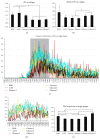Fractal analysis and the diagnostic usefulness of silver staining nucleolar organizer regions in prostate adenocarcinoma
- PMID: 26366372
- PMCID: PMC4558419
- DOI: 10.1155/2015/250265
Fractal analysis and the diagnostic usefulness of silver staining nucleolar organizer regions in prostate adenocarcinoma
Abstract
Pathological diagnosis of prostate adenocarcinoma often requires complementary methods. On prostate biopsy tissue from 39 patients including benign nodular hyperplasia (BNH), atypical adenomatous hyperplasia (AAH), and adenocarcinomas, we have performed combined histochemical-immunohistochemical stainings for argyrophilic nucleolar organizer regions (AgNORs) and glandular basal cells. After ascertaining the pathology, we have analyzed the number, roundness, area, and fractal dimension of individual AgNORs or of their skeleton-filtered maps. We have optimized here for the first time a combination of AgNOR morphological denominators that would reflect best the differences between these pathologies. The analysis of AgNORs' roundness, averaged from large composite images, revealed clear-cut lower values in adenocarcinomas compared to benign and atypical lesions but with no differences between different Gleason scores. Fractal dimension (FD) of AgNOR silhouettes not only revealed significant lower values for global cancer images compared to AAH and BNH images, but was also able to differentiate between Gleason pattern 2 and Gleason patterns 3-5 adenocarcinomas. Plotting the frequency distribution of the FDs for different pathologies showed clear differences between all Gleason patterns and BNH. Together with existing morphological classifiers, AgNOR analysis might contribute to a faster and more reliable machine-assisted screening of prostatic adenocarcinoma, as an essential aid for pathologists.
Figures






References
-
- Eble J. N., Sauter G., Epstein J. I., Sesterhenn I. A. Pathology and Genetics of Tumours of the Urinary System and Male Genital Organs. Lyon, France: IARC Press; 2008.
-
- Ferlay J., Steliarova-Foucher E., Lortet-Tieulent J., et al. Cancer incidence and mortality patterns in Europe: estimates for 40 countries in 2012. European Journal of Cancer. 2013;49(6):1374–1403. - PubMed
MeSH terms
LinkOut - more resources
Full Text Sources
Other Literature Sources
Medical

